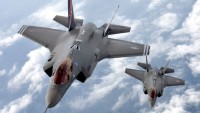Successor to F-22 Stealth Fighter will have Advanced Electronic Warfare Capabilities
| Arthur Dominic Villasanta | | Mar 25, 2017 08:20 AM EDT |
(Photo : USAF) Northrop Grumman's concept for Penetrating Counter Air.
The next generation U.S. air superiority fighter jet that succeeds the Lockheed Martin F-22 Raptor will possess stealth in abundance and a new attribute -- electronic warfare (EW) systems directed by artificial intelligence (AI) that automatically negate digital radars.
The U.S. Defense Advanced Research Projects Agency (DARPA) and the U.S. Air Force acknowledge the immense advantages offered by stealth technology are being whittled away by advances in radar technology. Chief among these threats to stealth are digitally programmable or adaptive radars such as those being developed by Russia and China as parts of their integrated air defense systems.
Like Us on Facebook
Adaptive radars are the greatest threat to U.S. warplanes. These modern radar systems can detect and characterize sources of electronic noise such as radio frequency jamming or co-location antenna interference, and adapt the radar's performance to compensate.
DARPA and the Air Force now plan to leverage advances in signal processing and AI to develop intelligent algorithms that detect and counter adaptive radars and other emerging radar threats.
This fusion of stealth and electronic warfare capabilities will be present in the Air Force's successor to the F-22, which will be a jet called Penetrating Counter Air (PCA). PCA will make extensive use of electronic warfare and new electronic warfare systems that use AI to automatically jam a new radar signal.
To ensure mission success in future anti-access/area denial (A2/AD) environments, EW systems will need to isolate unknown hostile radar signals in dense electromagnetic environments, and then rapidly generate effective electronic countermeasures.
In November 2016, DARPA awarded BAE Systems a $13.3 million contract modification to extend its work on the Adaptive Radar Countermeasures (ARC) project. The ARC program's goal is to enable airborne electronic warfare systems to defeat adaptive radars in real time.
Currently, only dedicated electronic attack aircraft such as the Boeing EA-18G Growler can identify and jam an unknown threat emitter. The F-22 Raptor relies on preprogrammed threat libraries that must be periodically updated to counter hostile radars.
The cognitive EW technologies developed for the ARC program employ advanced digital signal processing, intelligent algorithms and machine learning techniques.
TagsLockheed Martin F-22 Raptor, stealth, Electronic Warfare, digital radars, digitally programmable or adaptive radars, Penetrating Counter Air
©2015 Chinatopix All rights reserved. Do not reproduce without permission
 US Air Force B-21 ‘China Bomber’ on Track for Operational Service
US Air Force B-21 ‘China Bomber’ on Track for Operational Service US and Asian Countries Operating the F-35 Plan Combat Use of Stealth Fighter vs China
US and Asian Countries Operating the F-35 Plan Combat Use of Stealth Fighter vs China US will Deploy F-35 Stealth Fighters to the Middle East in the Next Five Years
US will Deploy F-35 Stealth Fighters to the Middle East in the Next Five Years US Generals say F-35 is 'a War Winner;' Want More of the Stealth Fighter Produced and Fast
US Generals say F-35 is 'a War Winner;' Want More of the Stealth Fighter Produced and Fast
EDITOR'S PICKS
-

Did the Trump administration just announce plans for a trade war with ‘hostile’ China and Russia?
-

US Senate passes Taiwan travel bill slammed by China
-

As Yan Sihong’s family grieves, here are other Chinese students who went missing abroad. Some have never been found
-

Beijing blasts Western critics who ‘smear China’ with the term sharp power
-

China Envoy Seeks to Defuse Tensions With U.S. as a Trade War Brews
-

Singapore's Deputy PM Provides Bitcoin Vote of Confidence Amid China's Blanket Bans
-

China warns investors over risks in overseas virtual currency trading
-

Chinese government most trustworthy: survey
-

Kashima Antlers On Course For Back-To-Back Titles
MOST POPULAR
LATEST NEWS
Zhou Yongkang: China's Former Security Chief Sentenced to Life in Prison

China's former Chief of the Ministry of Public Security, Zhou Yongkang, has been given a life sentence after he was found guilty of abusing his office, bribery and deliberately ... Full Article
TRENDING STORY

China Pork Prices Expected to Stabilize As The Supplies Recover

Elephone P9000 Smartphone is now on Sale on Amazon India

There's a Big Chance Cliffhangers Won't Still Be Resolved When Grey's Anatomy Season 13 Returns

Supreme Court Ruled on Samsung vs Apple Dispute for Patent Infringement

Microsoft Surface Pro 5 Rumors and Release Date: What is the Latest?










